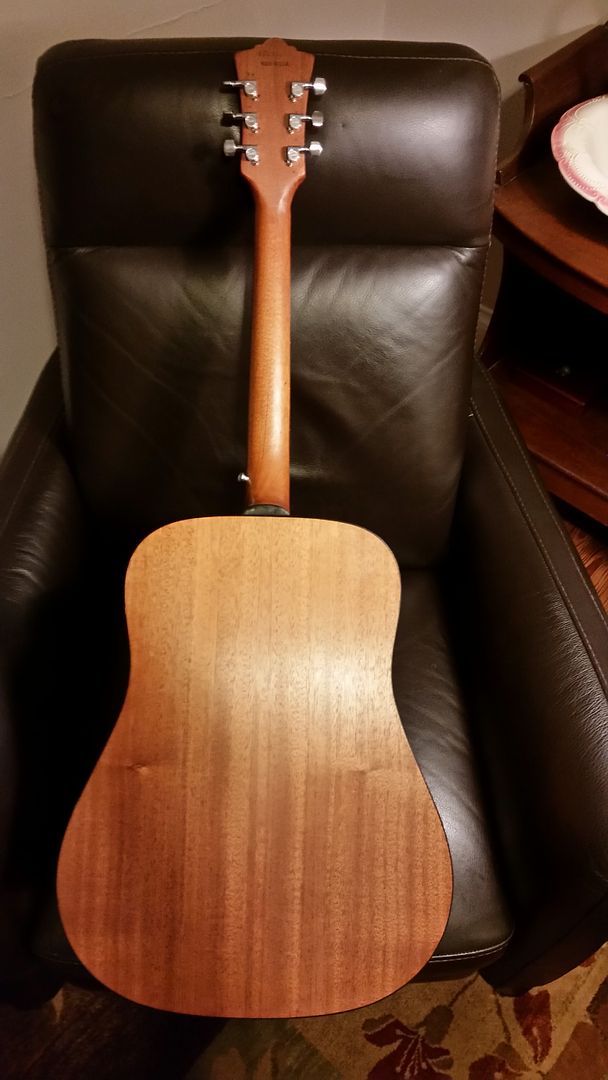Nitro does crystalize, or more accurately, outgas until such time as there are NO solvents left behind. In terms of flexibility, strangely enough, it is reduced, but the nitro is so well bonded to the wood that is essentially one piece. This is what makes the tone better, along with the reduced weight and thickness (we are talking at a microscopic level). This also what makes older nitro finishes so prone to checking and cracking.
All of the poly finishes are essentially a very, very thin sheet of transparent latex rubber on top of the wood. They do not bond to the wood as strongly, and their flexibility is partly what makes them so durable, and to some extent, a sound absorber that does not improve over time. Does it suck all the tone out of a guitar. Not by any means, but it does have a very slight more deteriorating effect on the guitar vs. what it would have been with a good, thin nitro finish. While the nitro finish will have less and less impact on the tone over time, poly (or to be completely accurate, catalyzed finishes) will have the same slightly negative effect for the entire lifespan of the guitar. Poly finishes are not the tonal disaster that many believe them to be, at least for modern poly finishes, but they do have more of a tonally detrimental effect than nitro, that doesn't improve with time.
Also, I want to make the point that ALL finishes adversely impact the tone of a guitar vs. the same guitar without finish. Finishes are a necessary evil, as the guitar needs some protection. At this point, the nitro and french polishes have the least detrimental effect on tone. They are more delicate, but nitro at least can be repaired relatively easily and when properly done, invisibly. It is perhaps the case where some poly finished guitars (like Taylors, when repaired by properly trained and equipped luthiers) can as well, but the vast majority can't. Most poly repairs are repaired by the use of cyano glues, because there isn't a luthier that can get the training or the equipment for all of the various poly finishes, even if there is a way of repairing some of the poly finishes properly (i.e. invisibly). We know that nitro finished guitars are delicate, and they will develop finish cracks and checks. Any good luthier can fix them, using standard nitro lacquers and solvents. Poly finishes are more durable and won't crack and check. However they will be damaged at some point, and the probability is very high that the repair will not be invisible, and will most likely consist of a bead of cyano in the crack, and then sanded down to be level with the surrounding poly.
Also note, that while we are obsessing over finishes, the choice of guitar strings, and guitar pick, if used, has more of an effect than the finish (of any type) does.
All of the poly finishes are essentially a very, very thin sheet of transparent latex rubber on top of the wood. They do not bond to the wood as strongly, and their flexibility is partly what makes them so durable, and to some extent, a sound absorber that does not improve over time. Does it suck all the tone out of a guitar. Not by any means, but it does have a very slight more deteriorating effect on the guitar vs. what it would have been with a good, thin nitro finish. While the nitro finish will have less and less impact on the tone over time, poly (or to be completely accurate, catalyzed finishes) will have the same slightly negative effect for the entire lifespan of the guitar. Poly finishes are not the tonal disaster that many believe them to be, at least for modern poly finishes, but they do have more of a tonally detrimental effect than nitro, that doesn't improve with time.
Also, I want to make the point that ALL finishes adversely impact the tone of a guitar vs. the same guitar without finish. Finishes are a necessary evil, as the guitar needs some protection. At this point, the nitro and french polishes have the least detrimental effect on tone. They are more delicate, but nitro at least can be repaired relatively easily and when properly done, invisibly. It is perhaps the case where some poly finished guitars (like Taylors, when repaired by properly trained and equipped luthiers) can as well, but the vast majority can't. Most poly repairs are repaired by the use of cyano glues, because there isn't a luthier that can get the training or the equipment for all of the various poly finishes, even if there is a way of repairing some of the poly finishes properly (i.e. invisibly). We know that nitro finished guitars are delicate, and they will develop finish cracks and checks. Any good luthier can fix them, using standard nitro lacquers and solvents. Poly finishes are more durable and won't crack and check. However they will be damaged at some point, and the probability is very high that the repair will not be invisible, and will most likely consist of a bead of cyano in the crack, and then sanded down to be level with the surrounding poly.
Also note, that while we are obsessing over finishes, the choice of guitar strings, and guitar pick, if used, has more of an effect than the finish (of any type) does.
Last edited:

